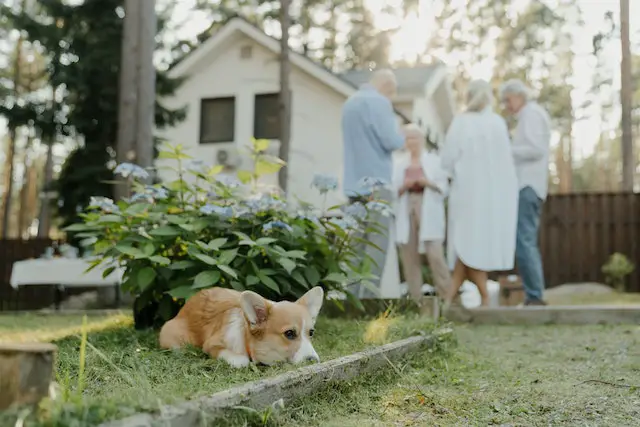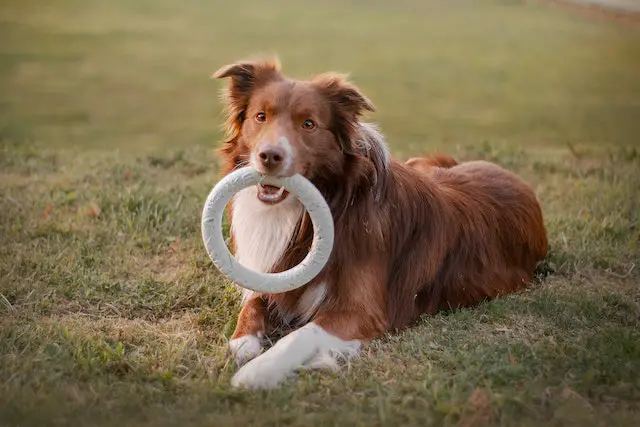Obesity can be simply defined as the surplus of fats in the body. Body fat and body weight go hand in hand. This is the reason why the majority of overweight dogs have excess body fat too.
When performing an assessment for dog obesity, body weight is used to check if they’re obese or overweight. Using this information, vets can know if a dog is overweight or not if they’re 10 to 20 percent above its recommended body weight. Dogs will be categorized as obese if they are weighing 20 percent or higher than their preferred body weight.
What Is Dog Obesity?
The truth is, dog obesity is a prevalent nutritional problem among dogs. Likewise, with humans, it is brought by the imbalance of consuming more calories than what is burned.
Naturally, the excess energy will be stored as fat. However, as owners, you should know that this isn’t the only factor contributing to your pet’s obesity. There are many elements that are at play similar to:
- Age
- Sex
- Activity level
- Reproductive status
- Underlying disease
Then again, there are breeds that are vulnerable to obesity. This is a clear indication that genetics play a part too.
How To Recognize If Dog Is Overweight?
If you feel clueless about whether or not your dog is overweight, don’t think twice to seek help from the pros. Preferably, your vet can give vital information in identifying the real score of your dog’s health
If you have Border Collie, Dalmatian, German Shepherd, and so forth, it doesn’t really matter. Feeling fats accumulating on your dog’s rib should be a red flag. The chest must also be broader than its stomach. It must also have a noticeable tuck-up form. You can use this as a tell-tale sign if your dog is overweight. Generally speaking, healthy dogs have no distinction between their stomach and chest and they have no visible waist too.
Why Is Obesity A Problem?

Chubby and fat dogs may seem to be cute indeed. But dob obesity is a real problem that should be addressed right away. Consequences await if it is taken for granted.
- Arthritis – the extra weight adds pressure onto the joints. This causes premature deterioration in the joint. Ultimately, it leads to arthritis. Of course, there are medicines that can be given to dogs to ease the pain. Nevertheless, weight loss and weight regulation can significantly help to eliminate the pain for good.
- Cardiovascular disease – the constant weight gain on your dog can eventually lead to heart problems as well as high blood pressure. It can be connected to breathing problems too. Truth is, overweight dogs are susceptible to collapsed trachea as well as laryngeal paralysis.
- Skin problems – extra skin folds are common among overweight dogs. If not treated, then it can result in bacterial infection and irritation. This could result in body odor, skin redness, and scratching.
What Are the Consequences & Risks of Obesity In Dogs?
Today, there have been multiple studies performed about excess fat deposits and weight. In the study, it revealed that there are major health complications that diminish our pet’s quality of life. Some of the conditions that shorten life expectancy are:
- Diabetes and Insulin Resistance
- High Blood Pressure
- Kidney Disease
- Osteoarthritis
- Cancer
What Causes Dog Obesity?
Dog obesity can be tied to a number of causes. The most common is the imbalance between the use and intake of energy. Simply put, the number of calories your dogs eat and the energy they spend on a daily basis. Aside from this imbalance, it is prevalent among older dogs due to their lower activity. Other known causes are:
- Neutering
- Insulinoma
- Hypothyroidism
- Hyperadrenocorticism or the Cushing’s Disease
What Are the Symptoms of Dog Obesity?
If you don’t know by now, there are many symptoms that can be used to identify whether the dog is obese or not. Some of these are lack of grooming and mobility, and difficulty in breathing.
- Lack of grooming – dogs love grooming themselves. If it comes to a point when their grooming frequency becomes less than normal, you should take it as a sign.
- Less mobility – this shouldn’t be interchanged with a sleepy animal. This might include the inability to go on walks, jump, play games, climb the stairs, or simply, disinterest. What’s sad about this is, it could impact the bond between the dog and its owners.
- Difficulty breathing – the constant panting of your Border Collie or other breeds most especially if they’re not doing much should be enough to concern any owner.
Other symptoms that loving owners should watch out for are weight gain, no palpable ribcage, excess body fat, lethargy, no or little visible waistline, and a distended abdomen
How To Diagnose Obesity in Dogs?
Diagnostic of obesity is done by measuring the body weight of the dog. Part of the procedure is also obtaining the BCS or Body Condition Score. BCS involves evaluating how much fat the body has. Most vets use BCS on a scale of 1 to 5 or 1 to 9 with 3 or 4.5 being normal respectively.
In an effort to figure out the best way to approach weight loss, diagnostic tests are done by veterinarians. A few of these tests are:
- A thorough examination which includes accurate measurement of body weight and BCS assessment
- Routine blood work that includes a complete serum profile, blood cell count, and urinalysis. All of these tests are done to know if there’s any underlying disease resulting to obesity
- Assessment of the daily diet of your dog from foods, snacks, treats, table foods, and even exercise activities and schedule
How To Treat Dog Obesity?
Treating obesity for your dog is concentrated on weight loss. It is then supported by regulating a healthy weight.
For humans, the approach to weight loss is by decreasing calorie consumption and increasing physical activity. The approach for dogs is not entirely different. Vets will be giving recommendations on feeding times, frequency of treats, ideal foods, portion sizes, and best exercise to do.
Dog Obesity Treatment via Dieting
Your vet can help in creating a diet plan, an eating schedule, and suggested calorie consumption per day. Dog weight loss that are packed with fiber and dietary protein and low in fat is the most common. This is because dietary protein is stimulating energy expenditure and metabolism.
Dog Obesity Treatment via Exercising

By increasing the physical activity of your dog, it helps in achieving effective weight loss. To do this, you can try out leash walking for 15 to 30 minutes or play a game of fetch.
Medication For Dog’s Obesity
One popular medication for dog obesity is dirlotapide. This is a selective microsomal triglyceride transfer protein inhibitor. The function of this drug is to prevent the formation of lipoprotein in enterocytes. Thus, increasing the concentration of lipids. This is believed to boost the hormone PYY. It’s a safety signal that reacts in the hypothalamus.
How To Recover Your Dog From Obesity?
As much as possible, always get help from a professional. Vets have the experience and knowledge to perform a thorough assessment of your pet’s condition, weight, and diet. Therefore, they can set the target weight that is best for your dog. At the same time, they can provide a weight-loss plan to make the goal easier.
Just remember that different dogs have different requirements. It’s natural that your dog’s ideal weight can be different from other breeds.
How To Prevent Dog Obesity?
While dog obesity is a real problem, the good news is, this is preventable. There are several things you can do to ensure your dog is healthy.
- Set a meeting with your vet – with your vet’s help, they can tell you the appropriate food for your dog’s diet. In preventing obesity, it’s critical to have portion control. Majority of the dog foods are overestimating in how much is needed. Be sure that you’re within the threshold by asking your vet.
- Schedule meal time – dogs are fast learners, especially if you have a Border Collie. They know when they eat and not. This helps in minimizing what is perceived as “begging behavior”.
- Interactive feeding toys – these toys make your dog work for their food. Dogs eat slower and the plus side here is, they spend more calories than they do.
- Don’t forget to exercise – a balance between proper diet and physical activities are vital to achieve optimal body condition. A lot of time so you can exercise your dog.
Adjusting Dog’s Diet

The idea of weight loss appears a simple task. You consume few calories and spend more than what you take in. Sadly, it is easier said than done.
Your dog must never be engaged in a diet without getting approval from your vet. Possibly, there are underlying issues that are causing or contributing to the excess weight of your dog. You don’t want to aggravate these issues simply because you thought that weight loss is about reducing calorie intake.
Protein
It is possible for overweight dogs to be in a healthy weight. This is achievable through caloric restriction and following a high protein diet. Experts agree that a dog’s diet with a high level of protein facilitates better weight loss.
Carbohydrate & Fat
The primary function of carbohydrates or carbs is to supply enough amount of energy. Carbs can either be an energy source or a source of fiber. By the time it’s consumed, one of the following could happen:
- It can be stored as fat
- Used immediately for energy
- Stored as glycogen in liver; it’ll be a reserved energy
Some dog owners think that low fat diet is good for their dog’s weight loss. While it can be, your dog could feel hungry all the time if there’s not enough fat consumed. This makes dieting more challenging for your dog. Possibly, it can force your dog to steal food or worse, eat their own poop. The best you can do is prepare a diet plan with an adequate amount of fat and reduce portion size.
Fiber
There was a study conducted among overweight dogs. They were fed with a high-fiber diet and reduced calorie consumption for a span of 24 weeks. It was discovered that the inflammatory markers and body composition of dogs changed throughout the period.
The subjects attained healthier weight while retaining their muscle mass and serum triglycerides. At the same time, inflammatory markers and insulin decreased along with their weight loss.
Exercise For a Dog With Obesity

Border Collies and other dogs love going for a hike, swim, run or walk. Make sure you get them out and enjoy these activities. Say that you are starting to exercise your obese dog, you must take things slow. Gradually increase the intensity of exercises by the time they are starting to lose weight.
After all, there are countless activities that you can do together. The ones below are just a few that you can begin with.
- Treadmill – looking for an activity that you can easily alter the impact to your dog? If so, then treadmill training is a wonderful alternative.
- Fetch – using discs and playing fetch with your dog is an effective way to get them moving. Start with a low-impact game and slowly increase its intensity as they are getting fitter and fitter.
Talk To Veterinarian About Your Dog’s Obesity Problem

Believe it or not, a lot of veterinarians are having a difficult conversation with dog owners when it comes to their overweight pets.
As for the owners, don’t feel offended if your vet is asking you questions about your dog’s health and diet. They do this to put an end to your dog’s obesity problem. Remember, your vet always has your best interest.
Is There a Connection Between Dog Obesity and Human Obesity?
Experts believe that there’s a connection between dog obesity and its owner. This suggests a common ground of obesity in dogs and humans.
In this matter, human doctors and veterinarians agree not just to the common causes of obesity but also, to the possible consequences associated with it. Then again, there are discrepancies between dog obesity and humans.
Obesity of Border Collies
If you notice that your Border Collie is gaining weight, it is often attributed to lack of exercise and overfeeding. Like what has been mentioned earlier, it’s smart to bring your Collie to your vet. Have them checked to be sure that there are no underlying issues in their weight gain like illness, metabolic changes, injury, and aging.
Now, if your Border Collie is obese, ask your vet about the best feeding regime for them to lose weight. From this point, they’ll be checking your dog’s medical history and current health condition.


